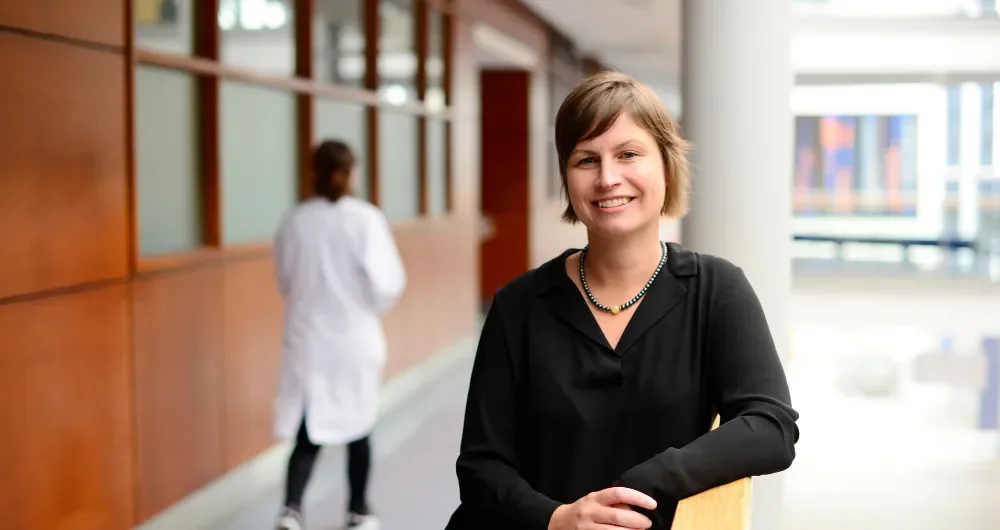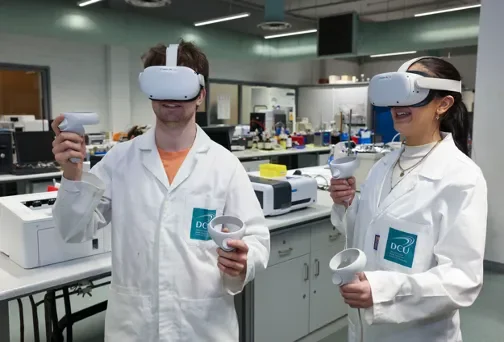

What the future of VR smells like
Our first use of VR is the School of Chemical Sciences, has been as a technology for training students in analytical chemistry practical techniques, said Prof Morrin, where the instrumentation the students train on can be very specialised and complex in operation.
Because of this, hands-on learning on the instruments can be limited to following standard procedures so that students don’t run the risk of damaging the instrumentation or indeed injuring themselves. More exploratory/investigative learning, although the holy grail, often becomes impossible because of these issues.
“The goal was to build out an laboratory environment in VR as a carbon copy of our own analytical chemistry laboratory” Prof Morrin explained.
“By interacting with chemicals, glassware and instrumentation in this virtual lab environment, our aim is that students learn techniques and instrument operation very efficiently and can explore them in more flexible ways than we can facilitate in the lab - we have no health and safety issues in here.We are on the road to fully building out this environment, but we are using aspects of it right now to train our current students.”
“The idea would be that we would always have hands-on learning time on analytical chemistry techniques and access to instrumentation for students in our physical laboratories, but the idea that they could train in our immersive VR environments to become proficient in a technique or instrument before coming into our real laboratory is very enticing,” said Prof Morrin.
“We know VR enhances learner engagement and knowledge retention and so we envisage training in these environments will make our students more efficient and confident as well as giving a greater depth of understanding for when they enter our physical laboratory for the first time.”

Smell
Ultimately, scientists are advancing virtual reality technology to allow us not only touch, feel and see but to also experience smell as part of the immersive experience, although this is some years off yet, said Prof Morrin. One of the most important senses, where there is a lot of innovative work going on at the moment, she said, is on the generating odours or fragrances that the user can experience while in VR.
“We have no smell perception of the VR environments we are in today, and this is a huge gap considering the importance of smell in sensory experiences,” said Prof Morrin.
There are challenges in creating such smells, she said, like freshly brewed coffee inside a VR coffee shop scene.
There has been a lot of innovation recently put into producing what are called ‘olfactory generator’ or OG technology, which produce scents.
“There are people working on building OGs into VR headsets or facemasks, so they can be triggered depending on what the user is experiencing in VR.” said Prof Morrin. “If the user is walking by a chip van in VR, then the smell of fresh chips being fried is given off.”
This is at an early stage, says Prof Morrin, but has enormous potential. There is huge commercial interest from, for example, supermarkets who want to introduce spontaneity into online or VR retail experiences.
To be powerful, the smell experience for the user needs to parallel the visual experience in VR for it to be realistic and help create associations. In the USA, scientists have demonstrated the technology to release odour at a rate that depends on how far away your nose is from the source of odour in the VR environment. This might help replicate the smell of freshly baking bread drifting over from another part of the VR supermarket.
One technology being used to create OGs uses a grid of containers filled with fragranced paraffin wax, said Dr Morrin. Once a smell is triggered, specific containers are heated to release and activate a precise smell. The resulting fragrance depends on the combination of containers that are triggered, and this smell wafts towards your nose.
Our sense of smell is important from a safety point of view, both in our every day life and also in the laboratory environment, where smell can often be a first indicator of something wrong.
OG technology is likely to be developed first for supermarket and other consumer goods shopping and for commercial opportunities in the gaming industry.
In the future we can expect our broader experiences in VR, such as within our laboratories and other environments to be enriched by smell and even taste, said Prof Morrin, but at some point we will have to decide on the limit to the sensory experiences that we want in VR – do we really want to smell soured milk in our fridges, or do we need to smell our virtual gyms?
